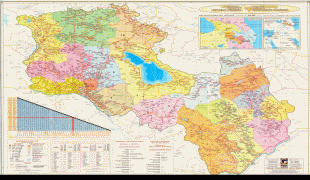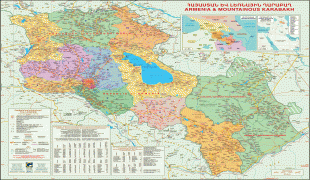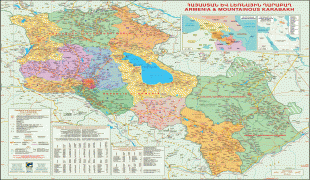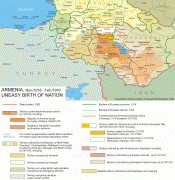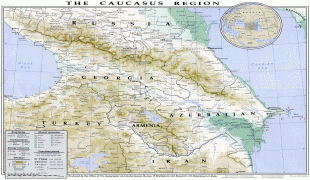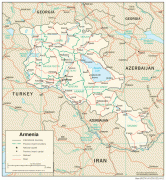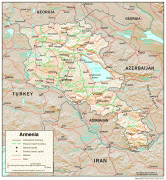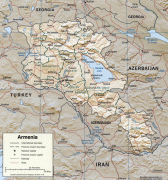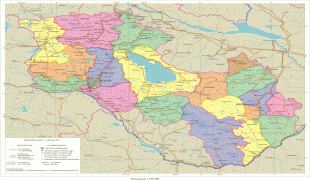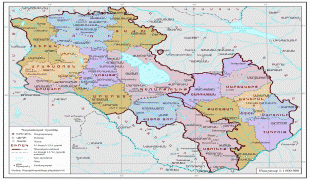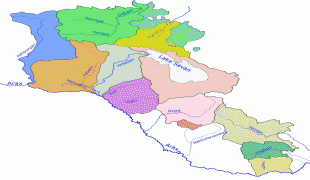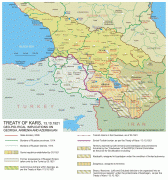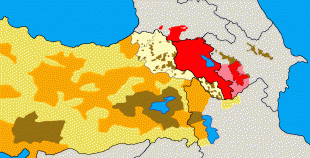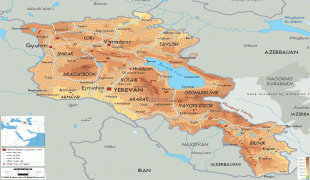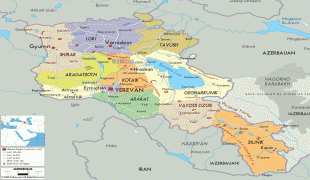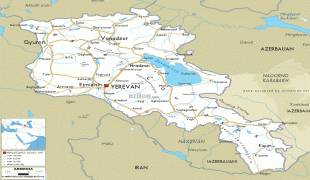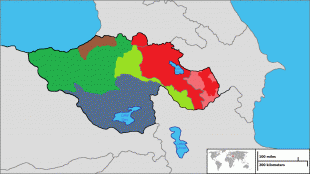Armenia (Republic of Armenia)
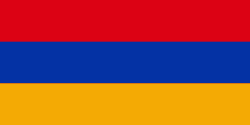 |
 |
| Flag of Armenia | |
Armenia is a unitary, multi-party, democratic nation-state with an ancient cultural heritage. The first Armenian state of Urartu was established in 860 BC, and by the 6th century BC it was replaced by the Satrapy of Armenia. The Kingdom of Armenia reached its height under Tigranes the Great in the 1st century BC and in the year 301 became the first state in the world to adopt Christianity as its official religion. The ancient Armenian kingdom was split between the Byzantine and Sasanian Empires around the early 5th century. Under the Bagratuni dynasty, the Bagratid Kingdom of Armenia was restored in the 9th century. Declining due to the wars against the Byzantines, the kingdom fell in 1045 and Armenia was soon after invaded by the Seljuk Turks. An Armenian principality and later a kingdom Cilician Armenia was located on the coast of the Mediterranean Sea between the 11th and 14th centuries.
Between the 16th and 19th centuries, the traditional Armenian homeland composed of Eastern Armenia and Western Armenia came under the rule of the Ottoman and Persian empires, repeatedly ruled by either of the two over the centuries. By the 19th century, Eastern Armenia had been conquered by the Russian Empire, while most of the western parts of the traditional Armenian homeland remained under Ottoman rule. During World War I, 1.5 million Armenians living in their ancestral lands in the Ottoman Empire were systematically exterminated in the Armenian genocide. In 1918, following the Russian Revolution, all non-Russian countries declared their independence after the Russian Empire ceased to exist, leading to the establishment of the First Republic of Armenia. By 1920, the state was incorporated into the Transcaucasian Socialist Federative Soviet Republic, and in 1922 became a founding member of the Soviet Union. In 1936, the Transcaucasian state was dissolved, transforming its constituent states, including the Armenian Soviet Socialist Republic, into full Union republics. The modern Republic of Armenia became independent in 1991 during the dissolution of the Soviet Union.
Armenia is a developing country and ranks 85th on the Human Development Index (2021). Its economy is primarily based on industrial output and mineral extraction. While Armenia is geographically located in the South Caucasus, it is generally considered geopolitically European. Since Armenia aligns itself in many respects geopolitically with Europe, the country is a member of numerous European organizations including the Council of Europe, the Eastern Partnership, Eurocontrol, the Assembly of European Regions, and the European Bank for Reconstruction and Development. Armenia is also a member of certain regional groups throughout Eurasia, including the Asian Development Bank, the Collective Security Treaty Organization, the Eurasian Economic Union, and the Eurasian Development Bank. Armenia supports the de facto independent Republic of Artsakh (Nagorno-Karabakh), which was proclaimed in 1991 on territory internationally recognized as part of Azerbaijan. Armenia also recognises the Armenian Apostolic Church, the world's oldest national church, as the country's primary religious establishment. The unique Armenian alphabet was created by Mesrop Mashtots in 405 AD.
The original native Armenian name for the country was Հայք (Hayk’); however, it is currently rarely used. The contemporary name Հայաստան (Hayastan) became popular in the Middle Ages by addition of the Persian suffix -stan (place). However the origins of the name Hayastan trace back to much earlier dates and were first attested in circa 5th century in the works of Agathangelos, Faustus of Byzantium, Ghazar Parpetsi, Koryun, and Sebeos.
The name has traditionally been derived from Hayk (Հայկ), the legendary patriarch of the Armenians and a great-great-grandson of Noah, who, according to the 5th-century AD author Moses of Chorene (Movsis Khorenatsi), defeated the Babylonian king Bel in 2492 BC and established his nation in the Ararat region. The further origin of the name is uncertain. It is also further postulated that the name Hay comes from one of the two confederated, Hittite vassal states – the Ḫayaša-Azzi (1600–1200 BC).
The exonym Armenia is attested in the Old Persian Behistun Inscription (515 BC) as Armina. The Ancient Greek terms (Armenía) and (Arménioi, "Armenians") are first mentioned by Hecataeus of Miletus (c. 550 BC – c. 476 BC). Xenophon, a Greek general serving in some of the Persian expeditions, describes many aspects of Armenian village life and hospitality in around 401 BC.
Some scholars have linked the name Armenia with the Early Bronze Age state of Armani (Armanum, Armi) or the Late Bronze Age state of Arme (Shupria). These connections are inconclusive as it is not known what languages were spoken in these kingdoms. Additionally, while it is agreed that Arme was located to the immediate west of Lake Van (probably in the vicinity of Sason, and therefore in the greater Armenia region), the location of the older site of Armani is a matter of debate. Some modern researchers have placed it near modern Samsat, and have suggested it was populated, at least partially, by an early Indo-European-speaking people. It is possible that the name Armenia originates in Armini, Urartian for "inhabitant of Arme" or "Armean country." The Arme tribe of Urartian texts may have been the Urumu, who in the 12th century BC attempted to invade Assyria from the north with their allies the Mushki and the Kaskians. The Urumu apparently settled in the vicinity of Sason, lending their name to the regions of Arme and the nearby lands of Urme and Inner Urumu. Given that this was an exonym, it may have meant "wasteland, dense forest", cf. armutu (wasteland), armaḫḫu (thicket, thick woods), armāniš (tree). The southerners considered the northern forests to be the abode of dangerous beasts.
It has also been speculated that the land of Ermenen (located in or near Minni), mentioned by the Egyptian pharaoh Thutmose III in 1446 BC, could be a reference to Armenia.
According to the histories of both Moses of Chorene and Michael Chamchian, Armenia derives from the name of Aram, a lineal descendant of Hayk. The Table of Nations lists Aram as the son of Shem, to whom the Book of Jubilees attests, "'And for Aram there came forth the fourth portion, all the land of Mesopotamia between the Tigris and the Euphrates to the north of the Chaldees to the border of the mountains of Asshur and the land of 'Arara'.'" Jubilees 8:21 also apportions the Mountains of Ararat to Shem, which Jubilees 9:5 expounds to be apportioned to Aram.
Currency / Language
| ISO | Currency | Symbol | Significant figures |
|---|---|---|---|
| AMD | Armenian dram | Ö | 2 |
| ISO | Language |
|---|---|
| HY | Armenian language |






